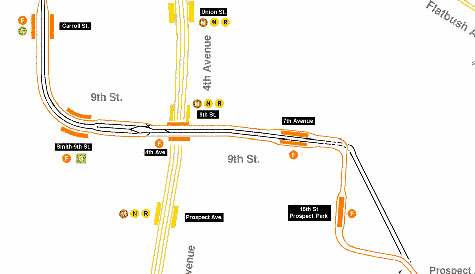
Those F express tracks sit unused, and Brooklyn residents want to see that changed.
When last I checked in on the petition to promote F service along the unused express tracks on Brooklyn’s Culver line, the movement, while presenting a very feasible plan, had yet to gain steam. Well, the last nine days have seen a whirlwind of attention, and what began as a response to a my dig at the F train has turned into a full-fledged movement.
Gary Reilly’s efforts to draw attention to an under-served and overused line have been written up in The Brooklyn Eagle, New York Metro and most thoroughly in The Brooklyn Paper. The Downtown Brooklyn Parternship, in their statement supporting Mayor Bloomberg’s congestion tax, voiced their call for F express service as well.
So the movement is growing. Newspapers and business associations are hoping on this bandwagon. So far, over 2000 residents have added their names to the petition as well. But the MTA is stonewalling. The Authority keeps insisting that they cannot restore express service to the F line until the work on the Culver Viaduct at 9th St. is completed in 2012. The Brooklyn Paper has more:
New York City Transit spokesman Charles Seaton said this week that the agency can’t consider restoring express service — which existed as recently as the early 1980s — until 2012, when a planned reconstruction of the elevated track between the Fourth Avenue and Smith and Ninth Street stations will be complete.
He said that “express service would not be possible” until then because track work associated with the job will require the G train to run to Church Avenue on the F route, taking up the track that would be available for the South Brooklyn fast lane. “New York City Transit will review the feasibility of F-line express service [when that project is complete],” he said, adding that the final decision will be based on need.
Meanwhile, Bill DeBlasio, a member of the City Council, says that the MTA is “looking into other ways to do F express” so that we don’t have to wait another five years for this much-needed service to arrive.
As The Brooklyn Paper noted, some transit studies have shown that the F express service would save up to 20 minutes for many commuters. It would increase train service to rapidly growing areas to the city on a subway line that is currently maxed out during rush hour. It’s time for Brooklyn to get this express service.
Next week, at the MTA meeting focusing on capital improvement projects, members at the forefront of this F express movement plan to bring this plan to the MTA. So the more support they have, the better the proposal will sound to the ears of those making the decision about the train service. Add your name to the petition, and let’s keep the movement going. This is a plan that will benefit everyone.

 It’s all Hemmerdinger, all the time, this week at Second Ave. Sagas. After news about
It’s all Hemmerdinger, all the time, this week at Second Ave. Sagas. After news about  When last we visted with H. Dale Hemmerdinger, he had
When last we visted with H. Dale Hemmerdinger, he had  With current MTA chair Peter Kalikow on the way out, Gov. Eliot Spitzer has named his choice for replacement. H. Dale Hemmerdinger, a New York real estate mogul and one-time head of the MTA’s Citizen Budget Commission, will get the job, The Times’ new CityRoom blog
With current MTA chair Peter Kalikow on the way out, Gov. Eliot Spitzer has named his choice for replacement. H. Dale Hemmerdinger, a New York real estate mogul and one-time head of the MTA’s Citizen Budget Commission, will get the job, The Times’ new CityRoom blog 
 Every week on Thursday, the MTA releases its press release of
Every week on Thursday, the MTA releases its press release of 
 When Mayor Bloomberg first announced his congestion pricing plan on Earth Day, I
When Mayor Bloomberg first announced his congestion pricing plan on Earth Day, I  In a (not very) groundbreaking article in Sunday’s The City section, The New York Times took a look at something Greenpoint residents and savvy subway riders have long known:
In a (not very) groundbreaking article in Sunday’s The City section, The New York Times took a look at something Greenpoint residents and savvy subway riders have long known: